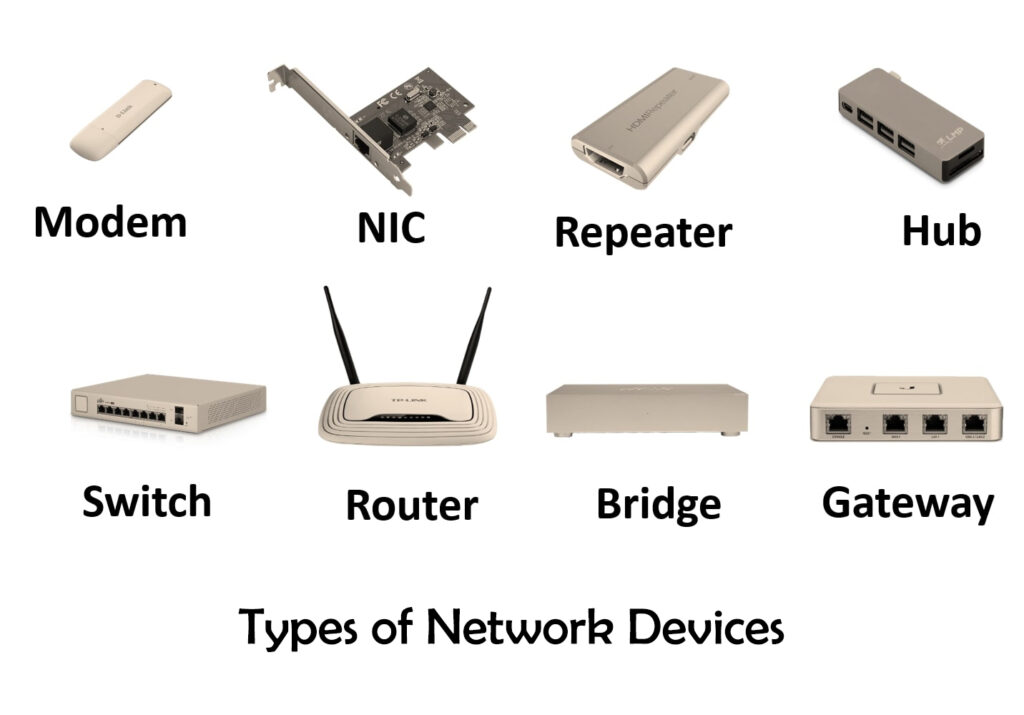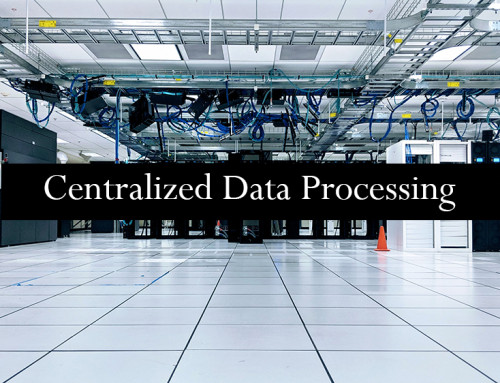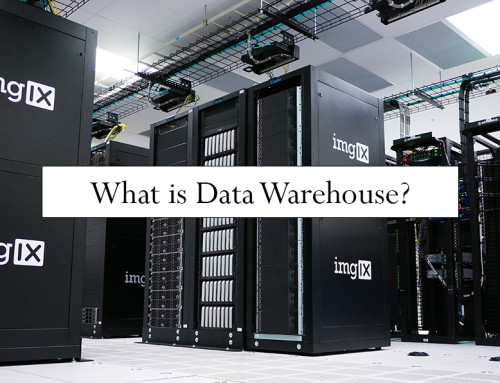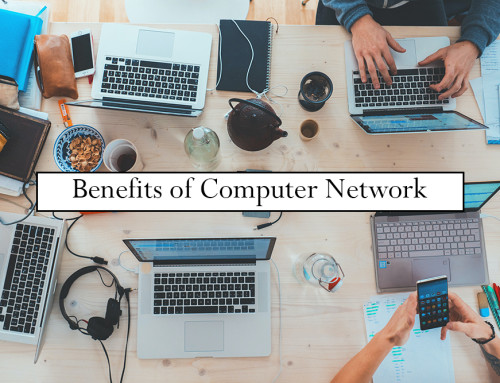What is a network device
“A network device is a hardware device that is used to connect computers, laptop, smartphones, printers, scanners with one another.”
These network devices work on different OSI layers. For example repeater and hub work on the physical layer and switch works on the data link layer.

Some network devices are:-
- Router
- Hub
- Switch
- Access Point (AP)
- Modem
- Bridge
- Gateway
- Brouter
- RJ45 connector
- NIC
- Load balancer
- Repeater
- Firewall
- Routing table
- Network-attached storage (NAS)
- Ethernet card
- Wi-Fi Card
Router
The router is a device that controls the traffic in the network. It connects two similar or dissimilar networks. The router works in both local area network (LAN) and wide area network (WAN). As a router is used in WAN so it is more expensive than any other network device. It can connect LAN and WAN networks. The main purpose of the router is to find a congestion-free path and then travels data through that path. Congestion free path means a path where packets of data are less. The router also connects two networks that have a large distance i.e. one network is in the USA and the other network is in India so the router wirelessly connects these two networks. The data transmission rate is high in the router. The router has an algorithm by which it can find a free congestion path. It works in both wired and wireless network.
There is one dedicated person needed to maintain a router. There is a security issue while transferring data to long distance. The data can be stolen in the way.
Hub
Hub is used to connect two computers. If computer A wants to send data to computer B then computer A sends data to the hub and then the hub broadcast the data to all the computers attached to the hub. Computer B then receives the data and other computers ignore the data. Hub is less intelligent, and has less cost. It is used in local area network (LAN).
The new connection is made easily by attaching the computer to the network. Hub has the transmission mode of half-duplex meaning that one computer either sends or receive a message at a time. Computers cannot send and receive data simultaneously. If there occurs any problem in the hub then the whole network stops working. Hub cannot provide extra security.
Switch
The switch is used to connect multiple computers in the network. It sends a private message from the sender to the receiver. It stores the MAC address of all the connected devices and upon receiving a message from the sender it first checks the MAC address of the message and then sends the message to the receiver that matches the MAC address.
Switch do unicast meaning it sends a message to only one receiver and not a broadcast message. It has high security than a hub. Also, the switch uses full-duplex transmission mode meaning computers can send/receive a message simultaneously. It is also difficult to set up a switch in the network.
Access Point (AP)
An access point (AP) is used to connect a wired network to a wireless computing device. Suppose there are four computers, a printer and a scanner is connected to a wired network. And there is another wireless network with four laptops. Now laptop computer cannot access the printer in a wired network. So to make this type of connection from wireless to wired network access points are used. The shape of AP looks like a modem. Old AP devices had antennas connected to them while new AP device comes with inbuilt antennas within device.
Modem
A modem is a short form of modulator-demodulator. It provides internet to the network that is connected through a hub or switch. A modem converts the digital data from our computer to the analogue data that is understandable by the telephone cables. The modem also converts analogue data from cables to the digital form that is understandable by the computer.
Modem receives/sends data from/to coaxial cables. The broadband or DSL network uses a modem.
Bridge
The bridge is a device that connects two LAN’s. It works on both physical and data link layers of the OSI model. Suppose you have to make the connection of two LAN’s through the bridge. When the connection is made then the bridge stores all the MAC addresses and port numbers of destinations computers in the LAN. When any computer wants to send data then the bridge checks the MAC address from the receiver and then find the LAN that has that MAC address. Then bridge transfer data to that LAN that has that MAC address matched.
Bridge broadcast the message like hub and repeater. In bridge data collision not occurs. The bridge is an intelligent device. Bridge connects two similar networks but not connect networks that are different. The bridge is a slower device and is expensive also.
Gateway
Gateway is a network device that connects dissimilar computers. It also connects similar networks but in most cases, it connects dissimilar devices. Sometimes switch also behaves as a gateway. Suppose a computer in the LAN network wants some data. If that data is present in the LAN then it will be provided by the gateway but if the data is not present in the LAN then the gateway will connect to the WAN and gets and transfer data to that computer.
Gateway works in all 7 layers of the OSI model. You cannot access the internet without using the gateway. It is expensive to buy a gateway and it provides some security. It is difficult to maintain a gateway and is less intelligent. The data transfer rate is slow in the gateway.
Brouter
Brouter is also known as bridge router and it works as bridge and router. If the brouter behaves as a bridge then it works on the data link layer. If brouter works as a router then it works on the network layer.
I have described the working of the router and bridge in the above text.
RJ45 Connector
Rj45 connector is used to making connections in Ethernet cable or any other network connection. It has 8 wires inserted into it. It is used to make network connection in the LAN. You can either use Rj45 to connect two laptops or PCs.
NIC
NIC is a short form of the network interface card. You cannot connect to the internet without NIC. NIC stores the MAC address of the computer but when you connect your computer to the internet then it uses an IP address or LAN address to identify the computer. There are two types of NIC:-
Internal NIC: Internal NIC is attached to the motherboard and it is connected to the Rj45 cable.
External NIC: External NIC is connected via USB or by wireless connection to the computer.
Security is weak by using NIC.
Load Balancer
Load balancing is distributing incoming traffic across a group of servers without intervention. The hardware or software which provide load balancing is known as a load balancer.
Suppose you have 2 servers and a user comes to the website then the load balancer will move the user to either server 1 or server 2 depending upon which server has low traffic.
Load balancing can be performed by various methods that include:-
- Load balancing through the hardware
- Load balancing through DNS
- Load balancing through software
Repeater
A repeater is a device that boosts/regenerate the data signals of the network. If a data signal travels a long distance then it becomes weak. To make the signal in its original shape we use the repeater. The repeater can be used in both wired and wireless network.
For example, in a TV cable network, we use a repeater to regenerate the signals so that we get a good resolution while watching TV. It is cheaper than other network devices. We may need a repeater after some distance. The repeater is unable to connect dissimilar network.
Firewall
Firewall stops unwanted traffic to come to your PC or laptop. A firewall is attached to protect the whole network or individual computer/device. You can stop data that comes from specific ports. Suppose you want to prevent traffic that comes from 40 and 133 ports. So when traffic comes from 40 or 133 ports then it will not reach your network or computer because the firewall blocks that traffic. And only traffic from the trusted ports you allow will come to your network.
Routing Table
The routing table is a type of rules that tells the router where the network traffic will be moved. In the routing table, there are different IP addresses. There may be local network addresses or global addresses. If you want to print a document then you will connect to a local address from the routing table. If you want to connect to any website then you will choose a global IP address from the routing table.
Network Attached Storage (NAS)
NAS is a storage device that can be attached to the network and that can store data in the network. Suppose you have 3 devices in the network. Device 1 can store photos and device 2 and 3 can store databases, movies, videos on a network storage device.
The issue with using NAS is that if the power supply fails in NAS then all the connected devices will not get data from NAS.
Ethernet Card
Ethernet cards are used to connect your computer with other devices. The data transfer rate of Ethernet range from 100 Mbps to 100 Gbps. Ethernet cards can work on physical and data link layers. Ethernet card can connect following cables:-
- Coaxial cable
- Twisted pair cable
- Fiber optics cable
Ethernet cables connect with the Rj45 connector. Data travel from Ethernet by using half-duplex mode and full-duplex mode. For using full-duplex mode two pair cable is used in Ethernet. Ethernet works with different network devices like a switch, hub, bridge, gateways etc.
Wi-Fi card
Wi-Fi is also known as wireless fidelity. Wi-Fi card is used to connect different devices wirelessly in the LAN. By using Wi-Fi users can download files, photos, do video conferencing and chatting. The physical area which provides internet access to the devices is known as a Wi-Fi hotspot.
Conclusion:
If you want to share your data over the network then you will need to connect to the LAN or WAN. For connecting to LAN or WAN your device should be connected to different network devices like modem, NIC, switch, hub, router and other network devices. Network devices help your data to travel among different locations. To protect your data you will also need a firewall.




